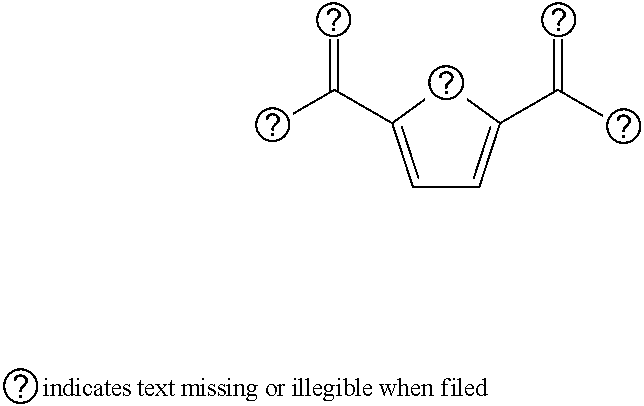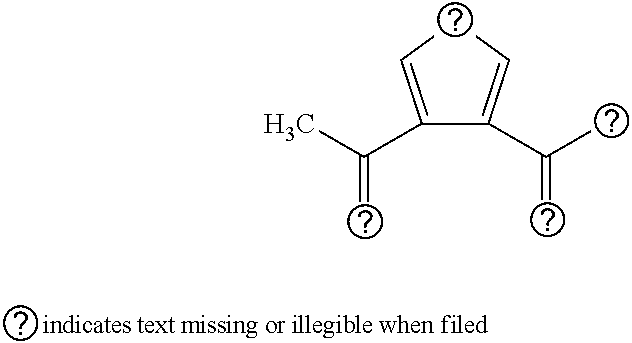Process for the production of poly(ethylene 2,5-furandicarboxylate) from 2,5-furandicarboxylic acid and use thereof, polyester compound and blends thereof
a technology of furandicarboxylic acid and polyethylene, which is applied in the field of polyethylene 2, 5furandicarboxylate, and the production of polyester compound and blends thereof, which can solve the problems of not teaching mechanical characteristics or % elongation of the proposed polymer in prior art references, and not teaching any polymer with adequate % elongation
- Summary
- Abstract
- Description
- Claims
- Application Information
AI Technical Summary
Benefits of technology
Problems solved by technology
Method used
Image
Examples
example 1
Purification of 2,5 FDCA
[0035]600 g of crude FDCA were added to 4 liters of pure water. 600 g of NaOH water solution (50:50 wt %) were added slowly to the FDCA solution whilst stirring. When the pH of the solution reached 5.5-6.5, the solution turned clear. The clear solution was deep brown in color. About 3 heaped tea-spoons of activated charcoal were then added to the solution. The solution was heated to 50-60° C. and stirred for 30 minutes. The solution was then run through a column with sand, Hyflo Super Cel® medium and silica beads to remove the charcoal. After filtering, the solution was clear with a slight yellow coloration.
[0036]The FDCA was then fractionated by adding concentrated HCl (33%) to adjust the pH of the solution to 5-6. At this stage, the solution became slightly cloudy. The solution was then stirred overnight before filtration to remove the first part of the precipitate. This fraction contains a small quantity of mono functional FDCA which would inhibit molecula...
example 2
Manufacture of PEF Samples
According to the Present Invention
[0040]A general synthetic procedure for the direct polymerization of FDCA and ethylene glycol is given below, using titanium(IV) isopropoxide
[0041](Ti[OCH(CH3)2]4) and antimony (III)oxide (Sb2O3) as catalysts:
[0042]The reaction conditions employed for the preparation of PEF samples are comparable to conventional synthesis methods for PET and those skilled / of ordinary skill in the art would be able to select alternative catalysts suitable for the task. Several procedures for the polymerization of PEF are shown below:
Sample A
[0043]In the first step of esterification, FDCA (100.25 g, 0.64 mol), EG (122.0 g, 1.97 mol), triol (THMP, 0.4353 g, 0.494 mol % of FDCA), 3,4 FDCA-methyl ester (4.8243, 0.0262 mol, 4.08 mol % compared to FDCA), and titanium(IV) isopropoxide (0.491 g) were added to the system. The mixture was heated to 170° C. for about 1 hour, 180° C. for about 1 hour, 185° C. for about 1 hour and 190° C. for 45 min. Aft...
example 3
Copolymer Properties
[0047]The determination of the number and weight average molecular weights and the molecular weight distribution (MWD) of the samples was performed using gel permeation chromatography. The instrument was calibrated with poly(methylmethacrylate) standards (PMMA). All molecular weights provided for the samples are PMMA equivalent molecular weights. The following conditions were employed:
[0048]Eluent: HFIP / 0.05M KTFAc
[0049]Columns: PSS-PFG, 7 μm, 100Å, ID 8.0 mm×300 mm
[0050]PSS-PFG, 7 μm, 1000Å, ID 8.0 mm×300 mm
Pump: Agilent 1200 HPLC-pump
[0051]Flow rate: 1.0 ml / min
[0052]Injector: Agilent 1200 Autosampler with 50 μl injection volume
[0053]Concentration: about 3.0 g / I
[0054]Temperature: 23° C.
[0055]Detectors: Agilent 1200 Differential Refractometer
[0056]Table below show the measured properties:
SampleMn (gmol−1)Mw (gmol−1)A46,000178,200B45,500160,800C29,20077,850
Control: conventional PET presents Mn 27,500 and Mw 66,440.
PUM
| Property | Measurement | Unit |
|---|---|---|
| melting point | aaaaa | aaaaa |
| melting point | aaaaa | aaaaa |
| wt % | aaaaa | aaaaa |
Abstract
Description
Claims
Application Information
 Login to View More
Login to View More - R&D
- Intellectual Property
- Life Sciences
- Materials
- Tech Scout
- Unparalleled Data Quality
- Higher Quality Content
- 60% Fewer Hallucinations
Browse by: Latest US Patents, China's latest patents, Technical Efficacy Thesaurus, Application Domain, Technology Topic, Popular Technical Reports.
© 2025 PatSnap. All rights reserved.Legal|Privacy policy|Modern Slavery Act Transparency Statement|Sitemap|About US| Contact US: help@patsnap.com



